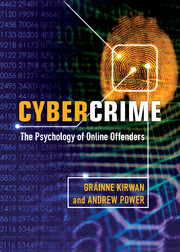Book contents
- Frontmatter
- Contents
- Detailed contents
- List of illustrations
- List of tables
- Preface
- 1 Psychology of cybercrime
- 2 Cybercrimes and cyberlaw
- 3 Hackers
- 4 Malware
- 5 Identity theft and fraud
- 6 Child predation and child pornography online
- 7 Cyberbullying and cyberstalking
- 8 Digital piracy and copyright infringement
- 9 Cyberterrorism
- 10 Crime in virtual worlds
- References
- Index
Preface
Published online by Cambridge University Press: 05 July 2013
- Frontmatter
- Contents
- Detailed contents
- List of illustrations
- List of tables
- Preface
- 1 Psychology of cybercrime
- 2 Cybercrimes and cyberlaw
- 3 Hackers
- 4 Malware
- 5 Identity theft and fraud
- 6 Child predation and child pornography online
- 7 Cyberbullying and cyberstalking
- 8 Digital piracy and copyright infringement
- 9 Cyberterrorism
- 10 Crime in virtual worlds
- References
- Index
Summary
This textbook examines the psychology of cybercrime. It aims to be useful to both undergraduate and postgraduate students from a wide variety of disciplines, including criminology, psychology and information technology. Because of the diversity of backgrounds of potential readers, this book presumes no prior knowledge of either the psychological or technological aspects of cybercrime – key concepts in both areas are defined as they arise in the chapters that follow. The chapters consider research that has been conducted in each area, but also apply psychological theories and models to each type of cybercrime. The chapters also consider many aspects of each cybercrime – they do not simply consider the offender, but also effects on the victims, suitable punishments, potential preventative measures and comparisons to similar offline offences. Most chapters stand alone, so it is possible for the reader to dip in to any point in the book. However, most readers may wish to start with Chapters 1 and 2, which provide an overview of forensic psychological theory and of cybercrime. We hope that you enjoy reading this book as much as we enjoy researching this evolving and cutting-edge topic.
Overview of the book
This book is divided into four sections. The first two chapters introduce the reader to the key concepts involved – specifically forensic psychology and cybercrimes. Following this, the book considers offences that could not exist without the use of computers; hacking and malware. The third section (Chapters 5 to 9) considers crimes that can occur without computers but that have become more prevalent or easier because of technology – such as copyright infringement, fraud, identity theft, terrorism, bullying, stalking, child pornography and sexual predation of children. The final chapter considers crime in virtual worlds.
- Type
- Chapter
- Information
- CybercrimeThe Psychology of Online Offenders, pp. xvii - xxiiPublisher: Cambridge University PressPrint publication year: 2013



